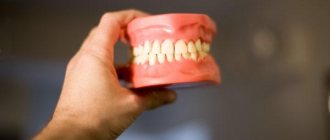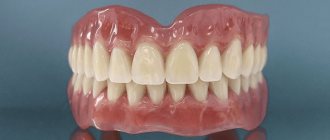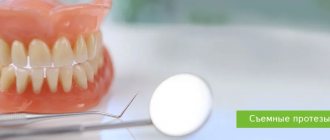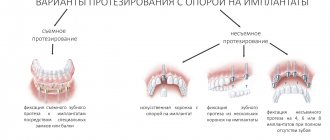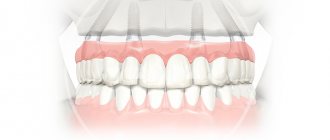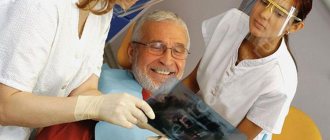Tooth loss can occur for a variety of reasons and under the influence of various factors. Sometimes a person loses several units due to injuries or dental diseases, but there are also cases of complete edentia. Restoration of dental units in the latter version can be carried out using various types of orthopedic structures, but experts recognize implant prosthetics in the complete absence of teeth as the most stable and durable method of restoration.
This procedure has significant differences with the techniques used for the loss of one or more dental units. We will get acquainted in detail with the features of the procedure, options for its implementation and prices for prosthetics on implants in the complete absence of teeth in the following sections of the article.
Calculate the cost of treatment by taking a short test in 20 seconds!
Do not delay your treatment, because in this matter time plays against us.
Complete edentia: possible options for dental prosthetics
If it so happens that the patient is missing all dental units in the oral cavity, then restoration with prosthetics on implants can be carried out using three main methods:
1. Traditional implantation. In this version of the operation, the patient is first implanted with implants, and after their integration with the tissues of the oral cavity, prosthetics is performed with fixed orthodontic structures.
2. Complete removable denture on mini-implants.
3. Conditionally removable prosthesis fixed on implants.
The second option allows you to significantly save your own budget and get excellent results from implant prosthetics at an affordable cost. Mini-implants will firmly hold the prosthesis in your mouth, and its daily use will not cause you the slightest discomfort.
Fixed prosthetics on implants is more difficult and expensive to carry out, but the patient will have the feeling of his own natural teeth in the mouth, and the design itself will be as comfortable as possible for daily use. Moreover, to implement permanent prosthetics on implants in the absence of teeth, it will be enough to implant no more than six artificial roots into the jaw bone.
Conditionally removable prosthetics are suitable for those who wanted to avoid the costs of traditional implantation and at the same time obtain an excellent and stable restoration result in the absence of teeth. Conditionally removable dentures are fixed in the oral cavity so firmly that it is impossible to remove them without the help of a specialist and, of course, they will not fall out during eating or active conversation, they do not need to be removed during the night's rest or after each meal. Below we will consider in detail the options for prosthetics on implants, taking into account the location of the treatment procedures.
Types of dental prosthetics on implants for the lower jaw
The lower jaw bone has increased thickness and density, and therefore, for prosthetics on implants in this area, a significantly smaller number of artificial dental roots are used - no more than six units. The process of osseointegration in this section of the jaw also occurs at an accelerated pace, over several months.
Removable prosthetics on implants in the complete absence of teeth in the lower jaw involves the use of two to four implants in the procedure. Most often, four implants equipped with attachments (micro-locks) are implanted into the patient. This method of prosthetics on implants in the absence of teeth has a number of advantages:
- Excellent prosthesis fixation rates;
- No need to carry out complex hygienic care procedures;
- The simplicity of the design of the prosthesis, making the price of the procedure as affordable as possible.
Partially removable dental prosthetics on two implants
When prosthetics on implants in the lower jaw area, only two artificial roots with attachments can be used: implantologists resort to this option when there is a clear deficiency of bone tissue for the installation of a larger number of implants. This method of restoration also has some disadvantages, the main of which will be the creation of pressure not only on the implants, but also on the soft tissues of the oral cavity. Such a load causes gradual atrophy of the gums, and in order to avoid such a negative phenomenon, the base of the prosthesis should be changed every six months and the strength of the attachments should also be checked.
Dental prosthetics - all-on-4 (all on four)
Another version of the prosthesis that can be used is a product with a beam-type fastening, for the installation of which in the mouth four titanium roots are first implanted - all-on-4 (all on four). This technique allows you to transfer unwanted load from the jaw to the implants and avoid the negative processes of reducing the volume of natural tissues, as well as obtain the strongest and most stable fixation of a removable denture. The orthopedic design in this case is made of polymer material, and adaptation to it occurs quickly and with a minimum of discomfort, and the prosthesis itself does not require specific care.
Dental prosthetics - all-on-6 (all on six)
Fixed prosthetics on implants is traditionally carried out using six implants, but it is also possible to carry out restoration in the area under consideration using the innovative method - all-on-6 (all on six), which involves installing two implants out of six at an angle of a certain degree. Fixed prosthetics on implants has a number of advantages, including a high level of aesthetics: a permanent prosthesis perfectly imitates natural teeth, and during the period of implant healing, the patient is given a temporary orthopedic structure (if immediate implantation was not carried out).
Implantation with screw fixation
Conditionally removable prosthetics on implants is carried out using structures fixed with screws in the area of manipulation. The denture is fixed so firmly that it can only be removed in a clinic, and this is important for patients who experience psychological discomfort from the fact that removable dentures need to be constantly removed from the mouth for hygiene, at night. Another advantage of conditionally removable prosthetics on implants is that, if necessary, the doctor can easily remove the prosthesis without damaging the structure itself, while other types of orthodontic products will be hopelessly damaged when removed - their integrity will have to be destroyed by sawing.
Upper jaw implantation
The bone in the maxillary region has a reduced density and therefore, in order to obtain the most durable fixation of the prosthesis, it is necessary to use a significantly larger number of units of implanted artificial roots - up to eight pieces. The process of integration with the tissues of the human body will also take longer – up to six months.
In removable prosthetics on implants in the absence of teeth, from four to six implants are used. A cover-type prosthesis with spherical attachments is usually fixed on four titanium roots. This type of orthopedic design will completely cover the palate, but if you want to install a prosthesis without a palate, keep in mind that it will be fixed on a significantly larger number of implanted implants, which will of course affect the final price of the procedure.
Dentures without a palate for removable prosthetics on implants in the complete absence of teeth can be fixed using micro-locks, locators, or a beam. The beam will provide maximum fastening strength, but the price of the prosthesis will be equal to the cost of a fixed orthodontic product.
Fixed prosthetics on implants in the complete absence of teeth in the upper jaw requires the preliminary implantation of six to eight implants; all-on-4 technology is also applicable to restore lost dental units. Implants are placed in the upper jaw in the traditional way, which allows you to get the most reliable, stable and durable result in permanent prosthetics on implants with complete edentia. The exact number of implants for the procedure is selected based on the condition of the bone tissue and the structural features of the jaw.
During the healing of the implants, the patient is given a prosthesis made of polymer material, which is subsequently replaced by a permanent structure made of dental ceramics or zirconium dioxide. Prosthetics on implants in the absence of teeth in the upper jaw can also be conditionally removable. In this case, implants with screw fixation in the jaw bone are used.
Four, six... or maybe three?
Nobel Biocare is rightfully considered a leader in the field of implantological innovations, although some of the solutions they offer are, to put it mildly, widely discussed in the professional community. So, most recently, she proposed the Trefoil concept, which allows the use of only three (!) implants to support a fixed prosthesis:
It is also worth noting that the All-On-4 scheme, i.e. “all-on-four” was also proposed by specialists from Nobel Biocare, and the rest, it seems, turn out to be “repetitive pigs”:
Of course, this does not mean that this concept cannot be implemented with other implants - of course it can, and we do it all the time:
The point is different:
Trefoil, like All-On-4, were developed and offered by Nobel with a lot of reservations regarding indications and contraindications; they are compromise schemes and, therefore, cannot be applied to all clinical cases.
The relative cheapness and apparent simplicity have led to the fact that some doctors have significantly expanded the indications for prosthetics using these methods - as a result, now we see not just a large, but a gigantic number of problems in the near and distant future. In fact, now we are seeing the same picture as with basal implantation, when a specific and extremely compromise method was turned into almost a panacea, “used” in absolutely all clinical cases. With predictable consequences, of course.
To prevent this from happening with four implants installed to support a fixed prosthesis, you should know that:
– the cheapness of such a design is a myth. The angled multifunctional abutments used in it are sometimes more expensive than two additional implants.
– for All-On-4 and especially for Trefoil, only original components of implantation systems can be used. Which is also reflected in the price, which is not at all positive. The use of counterfeit, counterfeit and incorrect spare parts is one of the main causes of complications, and very serious ones, such as fractures and loss of implants.
– the main reason why implants are placed at an angle is the desire to avoid expensive osteoplasty or sinus lifting in the lateral areas. You have to pay for this with an uneven and very compromise distribution of the load, in the vector decomposition of which a nonspecific component appears that sets the torque. Simply put, when the implant is placed in this way, the load on it is transferred and distributed in a way that is not at all how it should be distributed.
That is why such prosthetic schemes are recommended for patients with long-term absence of teeth and significant, at least 10-15 years, experience in using complete removable dentures. If we implement the “all-on-four” technique for prosthetics for a healthy man who lost all his teeth two months ago due to periodontitis, then with a high degree of probability we will end up with a lot of problems.
This technique cannot compensate for significant bone atrophy. Why? Because in this case, the massive base of a fixed prosthesis will create hygiene difficulties. In this case, it would be more correct to consider a removable denture supported by a beam fixed on implants, which we talked about a little earlier.
– immediate loading, such as “teeth in one day”, when implementing the “all-on-four” method is rare. It is not always possible to do this; this is rather the exception than the rule. All dentists are happy when this happens; they immediately run to post these works on their pages on social networks.
Why? Because of course it is possible to make a denture supported by installed implants, but to make a correct and functional denture is, unfortunately, almost impossible. Therefore, if you have the opportunity to avoid immediate prosthetics on implants, it is better to do so. If you hurry, you will make people laugh.
Therefore, we try not to load the implants immediately after installation, using the remaining teeth as support for the prosthesis:
If there are opportunities (namely, the remains of natural teeth), we use this approach quite often. Yes, it turns out to be more expensive than “all at once,” but it carries much fewer risks than immediate prosthetics itself. In particular, this applies to the “all-on-four” scheme.
And yet, when is “all-on-four” a good, usable technique? Frankly, we do not consider it a good and suitable technique even for the small number of clinical cases for which it is intended.
Those whales on which its popularity, speed, cheapness, simplicity rest, turn out to be not whales at all, but, at most, minnows.
Therefore, the only fixed structure that has the qualities we need is a bridge supported by six or more implants:
This technique can be considered a proven classic, because it is manufactured according to the same principles as implant-supported bridges.
The only difference is that often, very often, imitation gums are used to compensate for bone tissue atrophy (and increase interalveolar height):
Rarely, very rarely, usually with immediate implantation, we can do without artificial gum:
We classify such clinical situations as “LUCKY!”, because most often, in order to create teeth of the desired shape and height, the prosthesis needs some kind of base to compensate for the loss of bone.
Again, the type of prosthetics, removable or fixed, will depend on its thickness. If there is significant loss of bone tissue and the need for a thick base, it is better to consider the option of a removable denture supported by a bar. Then it will be much easier for the patient to care for it, therefore, we will not worsen the quality of life and will not reduce the service life of the structure itself.
The same goes for more implants - seven, eight, ten, twelve... Increasing the number does not improve aesthetics, will not get rid of artificial gums and will not improve your life if bone atrophy has gone too far. A simple example is basal implants, which are installed in dozens, but patients still remain dissatisfied.
And the quality of implantation and, especially, prosthetics means, first of all, a satisfied patient.
Unexpectedly for ourselves, we realized that it is impossible to talk about all the nuances of prosthetics in two or three articles. Having simplified some concepts, removed terms, made huge assumptions and adapted the text for ordinary people, we have not been able to present even half of what we consider necessary. No matter how much information there is about prosthetics, it will always be not enough. And there is an explanation for this.
With implants, everything is very simple - in fact, we have several dozen implantation systems and several hundred standard sizes. Whatever the implant, neither its brand, nor its shape, and especially the country of origin, determine the quality of the treatment performed.
At the same time, a denture, an aesthetic and functional imitation of a natural tooth, is individual and unique. Just as there are no two absolutely identical teeth in the world, there will never be two identical dentures. Dental prosthetics is always handmade, delicate and delicate, taking into account a thousand nuances and little details.
No matter what they say, no matter what marketers write about, a scanner-computer-milling machine will never replace a qualified dental technician and prosthetist. Not a single, even the most advanced computer program that operates with standard libraries of tooth shapes and sizes will reduce the relevance of the experience, competence, vision and simply aesthetic taste of the right doctor.
Suddenly a terrible event happened - a man lost all his teeth. If earlier it automatically transferred an active and young person to the category of an old man, now we have learned to restore entire rows of teeth with a high degree of reliability and an increase in the quality of life. For this purpose, we use dental implants as supports for dentures.
No matter what the advertising tells you, dental prosthetics is a long, complex and, unfortunately, very expensive treatment process.
The type of prosthetics (removable or fixed), as well as the number of implants (four, six or more) are selected based on the clinical picture and take into account a huge number of factors. Of course, we take into account all the “patients’ wishes,” but only if they do not contradict common sense and do not negatively affect the quality of prosthetics.
Therefore, when we talk about planning such treatment, its timing and, especially, cost, we need to act wisely and consider each case individually. The best option is an in-person consultation with a specialist doctor. All you need to do is call us, write to any of the instant messengers, leave a message on our social network page or simply fill out a form on the website, and then choose a convenient time to meet with the doctor.
Thank you for reading to the end.
As always, we are ready to answer all your questions in the comments under this article.
Best regards, CLINIC IN
What else can you read about dental prosthetics at CLINIC IN?
A whole section about dental prosthetics
You are planning dental prosthetics. What do you need to know about this before consulting a dentist?
Implant-supported prosthetics – how is it done?
A whole section on dental implants
Orthopedic implant platform – cones, hexagons and screws
About the quality of implantation
Prosthetics ALL-ON-4 all on 4 (all on four)
This method of implantation was created by specialists from the implant manufacturer - the world famous dental brand Nobel. When carrying out prosthetics on implants in the complete absence of teeth, this method involves the implantation of four implants into one jaw and loading them with a fixed-type prosthesis secured with screws. Implants implanted at the end of the dentition are placed at an angle of forty-five degrees, which helps to avoid affecting complex areas during manipulation: the area where the nerve exits and the maxillary sinus.
At the development stage, the method under consideration was planned to be as gentle as possible for patients, but in order to avoid a minimum of surgical interventions, a sufficient volume of bone tissue and its solid height are required. Without meeting these conditions, it is impossible to implant an implant of the required length into the bone, and shorter structures may simply not take root. In such options, patients are offered a procedure with the installation of not four implants, but six. Two additional implants will ensure uniform load on the natural tissues of the oral cavity and significantly reduce the risk of implant rejection.
Complications after complete implantation
Implantation in the absence of teeth rarely causes complications, since gentle technologies for this operation are used today. As a rule, they are associated with the individual characteristics of the patient’s body or non-compliance with the doctor’s recommendations in the post-implantation period.
- Complications that appear in the first 2 - 3 weeks and are directly related to surgical intervention: discomfort - goes away in 3 - 5 days;
- swelling and soreness are a sign of a rush of lymph, which helps eliminate inflammation; lasts up to 5 days;
- light bleeding or moderate bleeding – lasts no more than 3 days;
- suture dehiscence (applied during two-stage implantation) - the complication can be easily eliminated by treating the tissues with antiseptics, re-suturing and prescribing antibacterial therapy;
- implant rejection - the dentist takes individual measures, depending on the cause of rejection; This complication mainly occurs with frequent smoking.
When to see a doctor
You need to urgently run to the dentist if the following situation suddenly arises:
- sudden onset of fever with chills and severe pain,
- low (subfebrile) temperature will last more than three days,
- gumboil will grow on the cheek,
- the discharge of pus from the gums will begin,
- bleeding will continue for more than three days in a row,
- There will be a violation of the general condition - headache, malaise, weakness.
Bone grafting: is it always mandatory?
The need for bone grafting arises when the patient has a clear lack of natural bone material - in thickness or height. If this deficiency is small, then it is possible to combine operations and carry out all manipulations simultaneously with prosthetics on implants.
If the lack of natural bone material is pronounced, then before prosthetics on implants a series of manipulations will be carried out to build up the bone material to the required volume and only then the implantation itself. In this case, the restoration process will take a considerable time and may take a year or more.
However, it will be useful to know that in modern dentistry there are techniques that allow you to avoid the mandatory bone grafting procedures before implantation. For example, the restoration of not all dental units, but only up to and including the sixth unit in the dentition of the jaw will allow not to build up the bone in height, since the implants will be placed in the area of the front teeth, in which this indicator is usually normal, as well as in the “ fives." In the future, a permanent prosthesis will be fixed to the implanted roots, and this approach will allow you to obtain an ideal implantation result in terms of aesthetics and functionality without prior bone grafting.
If the height of the bone is normal, but there is a problem with its thickness, then implants of a special design, developed specifically for such cases, can help to do without bone grafting, but in this case it is worth choosing the right artificial roots for implantation. Not all implants from all manufacturers are able to withstand high loads.
FUN FACT: The best way to avoid bone grafting is to not put off restoring your teeth. The longer dental restoration is delayed, the more the jawbone becomes thinner.
Doctor's advice - why should you choose classic implantation?
It may seem that installing fixed prostheses using the classical implantation method is more expensive - it requires building up bone tissue if there is a lack of it, and temporary prosthetics for the period of healing of the implants. However, it is important to understand that you will get results for life without additional costs in the future. There will be no cost for special hygiene or replacement of fastening elements.
Levin Dmitry Valerievich
Chief physician, Ph.D.
Tips for choosing the type of implants
For prosthetics on implants, products of different types and from various global manufacturers can be used. Artificial roots for implantation are available in a wide range of types and prices, but not all of the implantation systems present on the market have passed the necessary clinical trials and time-tested. In addition, not all implant options are widely used in Russia, which can lead to difficulties if it is necessary to additionally order any components for the system.
When choosing a system for prosthetics on implants in the absence of teeth, you should first consider the options offered by world-famous manufacturers and widely used in modern dentistry. When selecting implants, close attention should be paid to its connection, since the density of the artificial root in the bone and its stability and ability to withstand increased loads depend on this element.
It is also worth studying the data on the material used to manufacture implants. Research shows that the healing process of those structures that are made of pure titanium occurs faster. The more impurities are added to the production material, the longer the process of integrating the implant with the natural tissues of the human body will take. No less important is the type of surface of the implants that will be used during the restoration process.
Each brand manufacturer processes implant surfaces using its own unique technology. Special treatment of the surfaces of implants from some companies makes it possible to ensure and accelerate the process of fusion of the structure with the natural bone material of the human body, and in addition, makes it possible to use implant systems in people suffering from various pathologies of the blood and blood vessels, and autoimmune diseases.
And one more key point: even after studying all the criteria for competently choosing implants for prosthetics, do not make your own choice of system. Only a qualified implantologist can select implants and the procedure method after assessing the clinical picture of a particular case. For detailed advice from a specialist in prosthetics on implants, contact our dentistry in Moscow - Vanstom! Address of our clinic: Moscow, Baumanskaya metro station, st. Bakuninskaya, 17/28.
Calculate the cost of treatment by taking a short test in 20 seconds!
Do not delay your treatment, because in this matter time plays against us.
Cost of prosthetics for complete absence of teeth
The price of prosthetics with implants if all teeth are missing is not cheap, but it is fully justified by its results: aesthetics, reliability, durability. Titanium roots can serve for many years without losing useful characteristics, so all costs for prosthetics will be covered. In addition, the implantation procedure is carried out in several stages and is also paid for - payment is made separately for each stage, which makes it possible to calculate and plan upcoming costs.
The final cost of the service for the patient will be influenced by a significant number of different factors, including: the type of orthodontic product, the material of its production, the type of implant, the manufacturer of the implantation system, the method of prosthetics, the need for additional therapeutic procedures before prosthetics. Having considered all the factors in determining the price of prosthetics on implants and taking into account all the features of a specific clinical case, it is always possible to choose the implantation option that will suit the patient in terms of quality, price and result.
However, remember - the price of implantation should not be a fundamental factor if you want to receive a service of decent quality. Neither the implants themselves nor the services of an implantologist can cost a penny, since the procedure is complex and requires the use of expensive consumables and equipment. Therefore, we advise you to contact not those clinics that attract patients with low prices in their price lists, but dentists that offer fair prices for implantation. In our dentistry in Moscow, Vanstom, you can get high-quality dental services at real prices! Come to our clinic: we are located next to the Baumanskaya metro station, in the center of the capital.
Expert opinion
Vladimir Aleksandrovich Voznyuk
maxillofacial surgeon, implantologist
Experience: more than 33 years
If a situation arises where there is not a single tooth left in the mouth, or their number is minimal, and the quality leaves much to be desired, it is necessary to solve the problem as soon as possible. Lack of normal chewing function, psychological discomfort from poor aesthetics, impaired diction - all this deprives a person of the opportunity to live a normal life. A removable denture has long ceased to be the only panacea. Today there are technologies that make it possible to restore absolutely all teeth with a guarantee of comfort, durability and safety of the result. Moreover, it is possible to personalize the solution to the problem by choosing the implantation option that is right for you.

